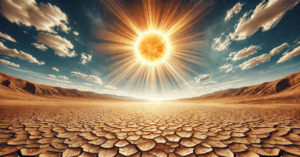Extreme Heatwave Hits India: 7 States Soar Above 40°C – Prepare for Intense Heat!
Several states in India are experiencing extreme heat, with temperatures rising significantly above the seasonal average. Odisha has seen temperatures surpassing 40°C, with Boudh recording 43.6°C. Maharashtra, including coastal areas like Mumbai, and interior regions like Vidarbha, have faced intense heat exceeding 40°C. Telangana and Andhra Pradesh are also battling high temperatures, with mercury levels crossing 40°C in many areas. Delhi has recorded 37.1°C, its highest of the year, while Gujarat’s temperatures have hit 41°C.
Punjab, Haryana, Uttar Pradesh, Bihar, and East Madhya Pradesh are seeing a rise in temperature, signaling potential heatwaves. The early onset of heatwaves in these regions is being fueled by factors like low rainfall and climate change. Residents are urged to take precautions as the heat intensifies.

Extreme Heatwave Hits India: 7 States Soar Above 40°C – Prepare for Intense Heat!
Large parts of India are reeling under an unexpected surge in extreme heat, with temperatures climbing far beyond what is typical for this time of year. The India Meteorological Department (IMD) has raised concerns over early heatwave conditions affecting eastern and western regions, driven by a combination of scanty rainfall and the broader impacts of climate change. Here’s a detailed look at the worst-hit areas and what locals and visitors need to know:
Odisha’s Scorching Reality
Odisha has emerged as one of the hottest zones, with temperatures crossing 40°C in multiple districts. On March 16, Boudh recorded a blistering 43.6°C, marking it as one of the country’s hottest spots. Cities like Jharsuguda (42°C) and Bolangir (41.7°C) are also baking under relentless heat, disrupting daily life and raising health risks for vulnerable populations.
Maharashtra’s Unrelenting Heat
Western India, particularly Maharashtra, is battling severe daytime temperatures, with many regions exceeding 40°C. Coastal areas, including Mumbai, faced unusual heat as early as late February, when the city hit 38.7°C—a staggering 6°C above normal. Inland areas like Vidarbha are equally affected, prompting the IMD to issue heatwave alerts much earlier than usual.
Telangana and Andhra Pradesh: Rising Mercury
Southern states are no exception. Telangana has seen temperatures soar past 40°C, intensifying its already warm climate. Neighboring Andhra Pradesh faces similar conditions, with dry weather and minimal rainfall pushing the state into heatwave territory weeks ahead of the typical summer peak.
Delhi’s Record-Breaking Warmth
The national capital recorded its highest temperature of the year on March 25, hitting 37.1°C—6°C above the seasonal average. While forecasts suggest temperatures could climb further, relief may come soon with rain expected in the region.
Gujarat’s Sweltering Conditions
Gujarat is grappling with temperatures as high as 41°C, affecting both coastal and inland areas. The combination of heat and humidity has made conditions particularly harsh, prompting advisories for travelers to stay hydrated and avoid outdoor activities during peak hours.
Other States on Alert
Northern and central regions, including Punjab, Haryana, Uttar Pradesh, Bihar, and East Madhya Pradesh, are witnessing a steady rise in temperatures. While these areas haven’t yet breached the 40°C mark, daytime and nighttime temperatures have climbed by 1-2°C. Uttar Pradesh stands out, with the IMD issuing a severe heatwave alert, urging residents to prepare for worsening conditions.
Why Is This Happening?
The IMD attributes the early and intense heat to two key factors: low pre-monsoon rainfall and climate change. Reduced rainfall has left the land dry, allowing sunlight to heat the ground more efficiently. Meanwhile, long-term global warming trends are making heatwaves more frequent, prolonged, and severe.
What Lies Ahead?
With summer still in its early stages, the IMD warns that heatwave conditions could spread to more regions. Nighttime temperatures are also rising, reducing opportunities for relief and increasing health risks. States like Uttar Pradesh and Odisha may face prolonged periods of extreme heat, straining power supplies, agriculture, and public health systems.
Staying Safe in the Heat
Authorities advise residents to:
- Avoid direct sunlight between 11 a.m. and 4 p.m.
- Stay hydrated and use oral rehydration solutions if needed.
- Wear lightweight, light-colored clothing.
- Check on elderly neighbors and children, who are more vulnerable to heatstroke.
A Glimpse of Hope
Some regions, like Delhi, might see temporary relief with forecasted rain. However, the larger pattern suggests a challenging summer ahead. The IMD continues to monitor conditions, urging state governments to implement heat action plans, including setting up cooling centers and disseminating public advisories.
As climate change reshapes weather patterns, India’s experience this year underscores the urgent need for adaptive measures—from better urban planning to water conservation—to mitigate the growing threat of extreme heat. For now, staying informed and cautious remains the best defense against the rising mercury.
You must be logged in to post a comment.